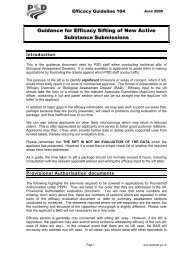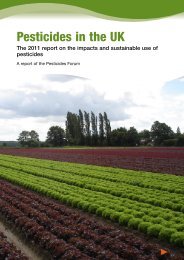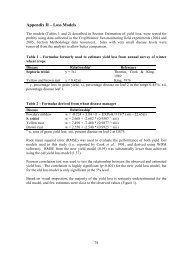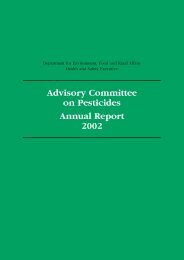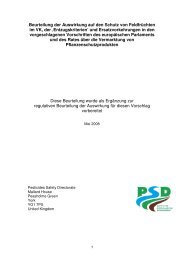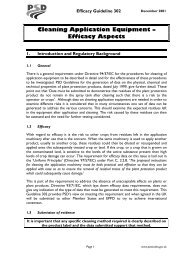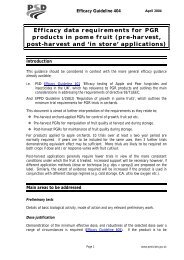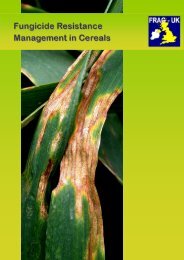Advisory Committee on Pesticides Annual Report 2001
ACP Annual Report 2001 - Pesticides Safety Directorate
ACP Annual Report 2001 - Pesticides Safety Directorate
You also want an ePaper? Increase the reach of your titles
YUMPU automatically turns print PDFs into web optimized ePapers that Google loves.
Secti<strong>on</strong> F: Other items c<strong>on</strong>sidered during the year<br />
did not prevent the loss of chlorothal<strong>on</strong>il. Losses, however, were not observed<br />
in extracts fortified with chlorothal<strong>on</strong>il, after prior removal of sulphurc<strong>on</strong>taining<br />
compounds by the use of an alumina column impregnated with<br />
silver nitrate. It was therefore tentatively proposed that silver nitrate should<br />
be added to frozen <strong>on</strong>i<strong>on</strong> subsamples before extracti<strong>on</strong>. The ACP had<br />
recommended that a further study be c<strong>on</strong>ducted into the use of silver nitrate<br />
and the use of acet<strong>on</strong>e c<strong>on</strong>taining 10N sulphuric acid as used by industry.<br />
Several other techniques were also examined, <strong>on</strong>e of which was the additi<strong>on</strong><br />
of orthophosphoric acid pre-milling.<br />
The additi<strong>on</strong>al study <strong>on</strong> <strong>on</strong>i<strong>on</strong>s was c<strong>on</strong>sidered at the January <strong>2001</strong> ACP<br />
meeting. The results showed that losses of chlorothal<strong>on</strong>il during the analysis<br />
of <strong>on</strong>i<strong>on</strong>s could be minimised by the additi<strong>on</strong> of 2.2M orthophosphoric acid<br />
to the samples before milling.<br />
The <str<strong>on</strong>g>Committee</str<strong>on</strong>g> recommended that:<br />
●<br />
●<br />
●<br />
the findings of these studies be passed <strong>on</strong> to the EU rapporteur<br />
(Netherlands) for c<strong>on</strong>siderati<strong>on</strong> when evaluating the methods of analysis<br />
used to analyse crop samples for chlorothal<strong>on</strong>il and commercial/domestic<br />
processing data;<br />
the use of orthophosphoric acid in the preparati<strong>on</strong> of subsamples of crops<br />
should be routinely adopted, when analysing <strong>on</strong>i<strong>on</strong>s (and other allium<br />
crops) for chlorothal<strong>on</strong>il; and<br />
industry should be informed of the findings and recommendati<strong>on</strong>s from<br />
the study.<br />
77<br />
How a broader approach to the protecti<strong>on</strong> of biodiversity may affect<br />
ecological risk assessments of plant protecti<strong>on</strong> products<br />
This report highlighted that the <str<strong>on</strong>g>Advisory</str<strong>on</strong>g> <str<strong>on</strong>g>Committee</str<strong>on</strong>g> <strong>on</strong> Releases to the<br />
Envir<strong>on</strong>ment (ACRE) c<strong>on</strong>siders the risks to biodiversity from genetically<br />
modified organisms, which has implicati<strong>on</strong>s for the ACP. On the basis of this<br />
report the ACP agreed to review its approach to wider biodiversity issues as a<br />
matter of some urgency. It c<strong>on</strong>sidered that the aim should be to take account<br />
of risks to biodiversity in the regulati<strong>on</strong> of pesticides and that the approach<br />
taken should be based <strong>on</strong> sound science. It was also agreed that the policy<br />
and management issues raised by the report should be discussed with the<br />
ACRE subgroup. Once a clear way forward was identified it would also be<br />
necessary for discussi<strong>on</strong>s to take place with relevant stakeholders.




